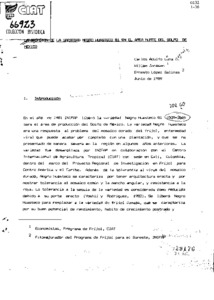La adopción de la variedad negro huasteco 81 en el área norte del Golfo de México
Abstract
In 1981, the National Institute of Forestry and Agricultural Research (INIFAP, its Spanish acronym) of Mexico released the black bean variety Negro Huasteco-81 in response to the problem of golden mosaic disease. In late 1988 and early 1989, an adoption study of the variety was conducted in Papantla, Veracruz; on the Huasteca plains, between San Luis Potosí and Veracruz; and in southern Tamaulipas. Among seven bean varieties planted by farmers, 28 percent corresponded to black bean `Negro Huasteco-81`. The main areas where the variety was planted were southern Tamaulipas (50 percent and a yield of 419 kg/ha) and in the district of Papantla (40 percent and a yield of 1108 kg/ha). These data coincided with the degree of knowledge about the variety: in Tamaulipas, 70 percent of farmers had heard about the variety and, in Papantla, 53 percent. In 1989, 90 percent of farmers of the Huasteca Plains had heard about the variety, but 27 percent did not plant it because of lack of seed or because they did not consider it an alternative. The variety`s outstanding characteristics, according to the farmers, were facility for mechanized cultivation (88 of farmers); tolerance of mosaic (80); plant architecture (78); high yields (65); resistance to rust (65); and resistance to drought (35). The lack of timely availability of seed limited the dissemination of the variety in Papantla and in the Huasteca Plains.

